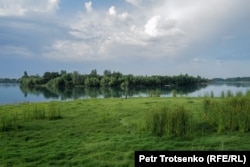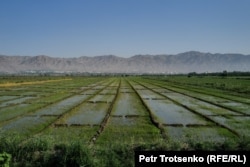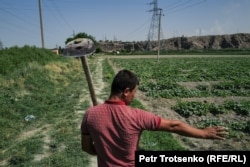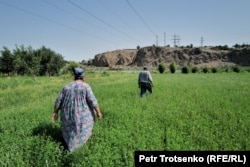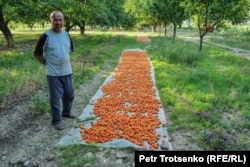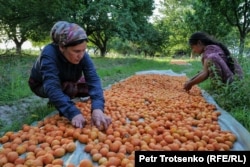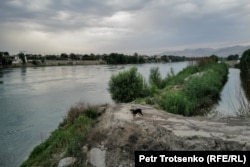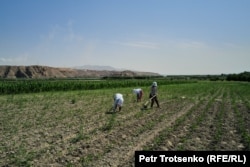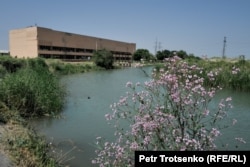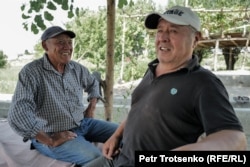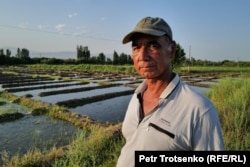Tajikistan's northern Sughd Region is a rich agricultural basin thanks to the Syr Darya River that transits the area. For 144 kilometers the river flows through Tajikistan -- barely enough for the multiple demands on its water from cotton, rice and fruit farmers, to two major hydropower stations.
RFE/RL photo correspondent Petr Trotsenko followed the river through Tajikistan to see how the Syr Darya River sustains life and influences geopolitics in Central Asia.
It's 4:30 a.m. when we set off to meet local farmers in Tajikistan's Sughd region. In these parts, you need to get your work done before the sun begins baking the landscape. During the week we spent in the region, the air temperature reached 50 degrees Celsius nearly every day.
Some 93 percent of Tajikistan's territory is mountainous, and the people know the value of fertile land. Along the border with Uzbekistan, the floodplain of the Syr Darya River is well utilized by local farmers. Most grow cotton. Farrukh Zabitov, head of the Fariza farm, got lucky with geography. His field sits right on the banks of the Syr Darya. But he pays for the time the water pumps that irrigate his fields are running.
"This year, the price of water increased by 150 percent," he says. "Previously we paid 20 somoni ($1.80) per hectare for one hour of watering; this year, we paid 50 somoni."
At the same time, "the price of cotton dropped so much that I couldn't make any profit from it," the farmer says.
Three years ago, 1 kilogram of cotton sold for 15 somoni, but in 2023 the price of 1 kilogram of cotton didn't rise above 5 to 6 somonis. "It would be good if we could get at least 10 somonis per kilogram this year," Zabitov said.
Cotton production is one of the most important industries in Tajikistan's economy. Some experts associate the drop in cotton prices with Russia's full-scale invasion of Ukraine and subsequent sanctions leveled at Moscow.
Russia, which was one of Tajikistan's main cotton buyers, is reportedly buying fewer raw materials due to the difficulty Russian businesses now face selling finished products to other countries.
"It has become very difficult," Zabitov says, before turning back to his work. In summer, every minute in the cotton fields counts.
During my visit to Tajikistan, I heard from several farmers that growing cotton has become unprofitable. Land taxes are increasing, water and fertilizer are expensive, and cotton has to be sold for a pittance.
Most of the farmers here worked on collective farms under the Soviets. As the U.S.S.R. collapsed, many of those workers ended up being able to lease the land of the farms from their newly independent state.
Farmer Abdullo Niyazov is one of those who rents a plot of land and has worked his fields for more than 30 years. Niyazov grows cotton on one of his plots and apricots on the other. The state requires the farmer to grow some cotton; otherwise, he says, he would grow only apricots. The fruit trees require little attention, and there is always a steady market for dried apricots.
Niyazov's entire family are involved in picking apricots from their 25 trees. The harvest is a critical time -- if the fruit is not picked in time and dried properly, it will rot.
Explaining how he irrigates his fields from the Syr Darya River, Niyazov tells me, "We have a ditch running through here, and a pump is installed with a water meter," he says. "We pay a bit more for the water because our plot is far away from the river."
He maintains the pump at his own cost.
"The apricot trees don't need much water, but cotton is very thirsty. We'll see what our income is like in the autumn," he says.
We met Nehmatullo Mirsaidov, a journalist and expert on agriculture and water resources, in one of the teahouses on the banks of the Syr Darya in Khujand, Tajikistan's second-largest city. A cool breeze from the river offered relief from the baking heat of the plains.
The expert says that stresses on the river are increasing due to drought, the shrinking of glaciers due to climate change, and the inefficient use of water, mostly by cotton farmers.
"The water of the Syr Darya is not being used wisely. In particular, it is being used inefficiently in Turkmenistan and Uzbekistan, which grow significantly more cotton than in Tajikistan," Mirsaidov says.
"I believe one way to solve the water problem is to reduce cotton production and switch to horticulture," he says. "Despite the fact that the land is leased to private farmers in Tajikistan, the state still requires them to grow cotton. Ideally, cotton should only be grown in sufficient quantities to be processed domestically. However, it seems it is profitable for some to buy raw materials from farmers and sell them on the foreign market."
According to Mirsaidov, cotton cultivation is gradually decreasing in Tajikistan, Uzbekistan, and Turkmenistan; however, cotton still remains those countries' main agricultural product. The specialist suggests the shortage of irrigation water could be solved by introducing modern technologies such as drip irrigation or by using rainwater.
"Of course, it is not cheap, but sooner or later we have to do it," the specialist says. "We need to attract funding from abroad, but foreign investors tend not to be interested in Tajikistan because our land is not privately owned. There is no guarantee that foreign investors will not lose their money tomorrow."
In the Sughd region on the Syr Darya River, there are two hydroelectric power plants (HPPs), Farhad and Kairakum.
The Soviet-era Farhad Dam is located in the territory of Tajikistan, but its power station is owned by Uzbekistan. The unusual arrangement is a result of a conflict over the facility that erupted amid Tajikistan's 1992-97 civil war.
A long-running dispute between the two countries was resolved only in 2018 when Tajikistan and Uzbekistan signed an agreement in which Tajikistan agreed to guard the facility while operation of the power station would be carried out by Uzbeks.
Most of the people living on the Tajik side of the border here are ethnic Uzbeks but speak Tajik well and consider Tajikistan their homeland.
Azat is a 57-year-old ethnic Uzbek who oversees the pump that delivers water from the Syr Darya River up to the mountain villages of the Spitamen district. He used to work as a teacher.
"Now there are no male teachers left in schools, only women," said Azat, describing how his teaching career ended. "That's because the monthly salary is low. I made an average of 700 somonis ($65) a month. It's impossible to support a family on such a pittance."
Now he works at the pump part-time and tends livestock at his home nearby.
Azat makes sure the six pumps at the station push out the right amount of water to those who need it.
"You call and tell me to send water, and I'll turn on the pump and the water will flow," Azat says proudly of his role in irrigating the district.
"This year, there has been enough water in the Syr Darya, but last summer there was very little," Azat says. "Everything depends on the snowfall. If the snow falls heavily in the mountains, there will be a lot of water.
"Much of the water flows into the Syr Darya from the Andijan and Osh glaciers in Kyrgyzstan. When there is a lot of water, Kyrgyzstan allows more water to flow here; and when there is less water, they don't want to lose any. They also have their own land and people."
Around 55 kilometers east of the Farhad power station, the Kairakum HPP has been operating since 1957.
Behind the dam of Kairakum, the Syr Darya is backed up in a massive reservoir known as the Tajik Sea.
The artificial lake is crucial for the region. In 2021, amid a severe drought, Tajikistan allocated some 315 million cubic meters of water from the reservoir to Kazakhstan.
Along the shore of the Tajik Sea, locals swim and fish, while farmers grow cotton, rice, cucumbers, and tomatoes.
In a rice paddy that runs up to the edge of the reservoir, Abdullahob expresses gratitude for his farm's proximity to the water. The 54-year-old is able to harvest up to 2 tons of rice in a good year. At a local market, he nets enough profit to provide for his family.
"The variety of rice I grow is called kenja. It's good for pilaf because the grains are small," Abdullahob says. "Everything grows well here. If you are vigilant and apply fertilizer at the right time, the yield will be good. Of course, a lot of water goes into the rice, but that water flows right back into the sea. Rice and water are twins."
Abdullahob wants to work here at least until he retires and then pass it on to his children or grandchildren.
"The most important thing is that I am healthy enough to work," he says. "And that there is water."
This is the second installment of a series of photo stories from the Syr Darya River and its tributaries. The waterway passes from the mountains of Kyrgyzstan through Tajikistan, Uzbekistan, and finally into the Aral Sea in Kazakhstan. Photo correspondent Petr Trotsenko from RFE/RL's Kazakh Service followed the length of the river to document how it sustains life in Central Asia and spoke to experts about the current state of this vital waterway. The first installment can be viewed here.





